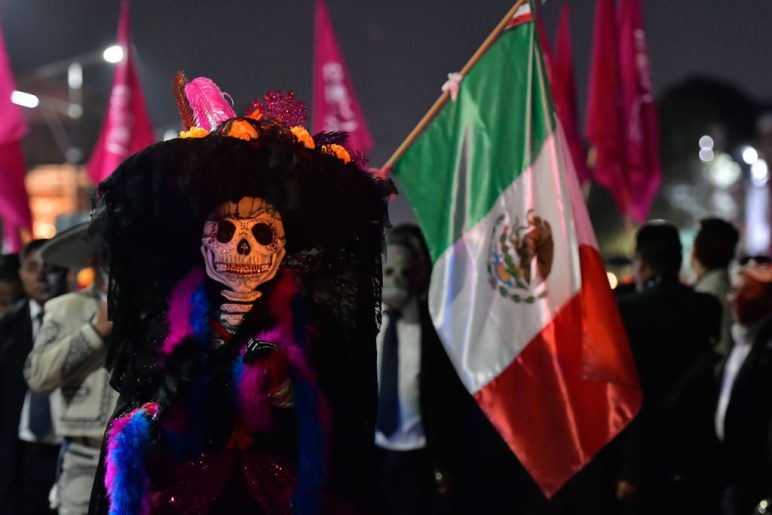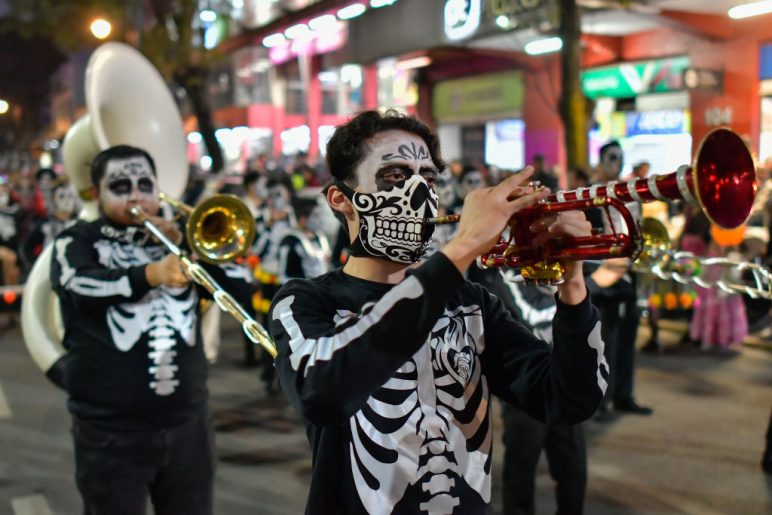Ángela Aguilar •
Rosalia •
El ‘Día de Muertos’ (Day of the Dead) is one of the most emblematic and important celebrations of Mexican culture. It takes place on November 1st and 2nd, coinciding with All Saints’ Day and All Souls’ Day, respectively, in the Catholic calendar. Despite its name may give the impression that it is related to death, it is actually a celebration of life through the commemoration of those who have passed away. In recent years, this celebration has gained international recognition.
Origins & Traditions
El Día de los Muertos has its roots in the ancient pre-Hispanic civilizations of Mexico. For most of these ancestral cultures, death was an object of veneration in various forms. In this context, it was considered a natural and inevitable part of the cycle of life, and firmly believed that the souls of the deceased continued to exist in a spiritual realm after their departure. Additionally, it was held that the fate of the departed was influenced by the way they lived during their time in the earthly world.
When Spanish conquistadors arrived in America, this belief merged with Catholic traditions. Currently, the Day of the Dead involves a series of rituals and traditions that vary by region in Mexico but share common elements. The ‘Catrina’ is a Mexican symbol that represents a significant aspect of the Day of the Dead celebration.
Ofrendas (Altars)
This is undoubtedly the most significant element. Families create altars in their homes –or in cemeteries– to honor their deceased loved ones. These altars are richly decorated, usually with flowers (especially ‘cempasúchil’ (marigold)), candles, sugar skulls, ‘pan de muerto’ (bread of the dead), food, drinks, and personal items of the deceased.
Catrina
La Catrina is one of the most iconic and significant symbols in the context of the Day of the Dead in Mexico. This figure represents an elegant and skeletal lady dressed in high-society clothing, often adorned with a flowered hat. La Catrina was created by the famous Mexican illustrator José Guadalupe Posada in the early 20th century and has become an emblematic representation of the celebration.

The Influence of ‘Día de los Muertos’ in Music
Now, taking into account everything mentioned above and understanding the various elements that make up the Day of the Dead, it becomes easier to identify these same elements in music. As mentioned earlier, this tradition has gained international recognition and popularity in recent years. For this reason, several artists have incorporated it into their art, whether directly in their music, in their artistic videos, or as a source of inspiration.

«La Llorona»
Celebrated as one of the iconic tracks in the Mexican popular music repertoire, ‘La Llorona’ traces its origins to the region of the Isthmus of Tehuantepec in Oaxaca. The most renowned rendition is by the late Costa Rican singer Chavela Vargas. Other notable interpreters include Mexican artists such as Lila Downs, Aída Cuevas, and Natalia Lafourcade.
In recent years, this timeless song has gained newfound popularity among younger generations, largely owing to Ángela Aguilar. She recently delivered a stirring performance of ‘La Llorona’ before thousands of spectators in Mexico City’s Zócalo during the grand parade dedicated to the Day of the Dead.
Angela Aguilar
Rosalía
Carmen Goett
«Remember Me»
«Recuérdame» is the signature theme song from the Disney Pixar film, «Coco.» This heartfelt track has been interpreted in various versions, including one by Carlos Rivera, who recorded the Spanish version for Latin America, and «Remember Me» in English, performed by Miguel and Natalia Lafourcade. Notably, the song was also performed by the Latin actor Gael García Bernal during the 2018 Oscars ceremony, where it won the award for Best Original Song.
Prayer In C (Robin Schulz Remix) – Lilly Wood & The Prick and Robin Schulz
In 2013, this song emerged as one of the year’s anthems, notable for its abundant incorporation of elements from the Day of the Dead.
«We Are The People» – Empire of the Sun
Another famous song from 2013, this was the second music video released from Empire of the Sun’s debut album, Walking On A Dream. Not only does it feature many references to Mexican culture, but it also incorporates a lot of elements from the Day of the Dead, making it a significant representation. The video was filmed on location in the towns of Garcia, Xilitla, and the Icamole Desert in Mexico.
«Flores Y Tierra» – Danny Felix
Phoenix-based singer Danny Felix, a trailblazer in the corridos tumbados genre, has shared «Flores y Tierra,» a composition he dedicated to those dear to us who have departed from this world. The accompanying music video depicts Felix delivering a heartfelt performance of the song amidst a cemetery in broad daylight, creating a emotional homage to the occasion.
«Las Flores del Camposanto» – Lupita Infante
The Mexican-American singer, who happens to be the granddaughter of the iconic Mexican actor and singer Pedro Infante, released a magnificent mariachi rendition of the song originally written by Luis Rosado Vega and performed in 1986 by the late Mexican singer-songwriter and musician Óscar Chávez. Infante recorded this piece as a heartfelt tribute to those who have departed from this world and to the serene resting places they inhabit –the cemeteries.
«The Life And Times Of A Teenage Rock God» – Rob Zombie
Distinct from other songs given its genre, Rob Zombie drew profound inspiration from Mexican culture and the Day of the Dead for this music video. In the video, all the musicians are adorned in mariachi attire, ‘skull candy’ makeup, skulls, cempasúchil flowers, and traditional Mexican clothing. You can enjoy a different but representative visual experience at minute 1:55.


